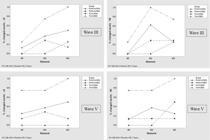ABSTRACT
Purpose
To follow up the central auditory system of children born small for gestational age, through electrophysiological evaluation of hearing, in order to verify the occurrence of possible neural dysfunctions in this system.
Methods
A longitudinal study was carried out with 23 children divided into four groups: Term-born group, subdivided into small for gestational age (four children) and four children born with appropriate weight for gestational age, whose age at the end of the research was three years old. Preterm group subdivided into small for gestational age (seven children), and appropriate for gestational age (eight children), whose corrected age, at the end of the research was three years old. All children were subjected to assessment of auditory brainstem auditory evoked potentials at birth, at six months and at three years of age, and Long-Latency Auditory Evoked Potential at three years.
Results
children born at term and small for gestational age had a higher occurrence of hearing alterations in relation to the other groups, with increased latency of waves III and V and interpeaks I-III and I-V. All children presented normal evaluation in the Long-Latency Auditory Evoked Potential.
Conclusion
Children born term and small for gestational age present dysfunctions in neural conduction in the brainstem and should be considered at risk for alterations in the development of the auditory skills that are necessary to guarantee quality of acoustic information processing.
Keywords:
Evoked potentials, Auditory, Brainstem; Hearing; Hearing disorders; Infant, Newborn; Child development

 Thumbnail
Thumbnail
 Thumbnail
Thumbnail
 Thumbnail
Thumbnail


